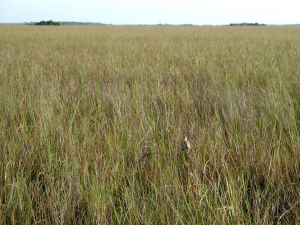Posted December 16, 2016
By MICHAEL FRANCA
FLORIDA CITY, Fla. — A study released in November revealed that a Burmese python found in the Everglades had consumed three deer in about three months. This discovery raises serious questions about the effects of exotic wildlife on the environment of Everglades National Park.
The snake –– measured at more than 15 feet in length –– was actually found and killed in June 2013. The study that brought this to light was released in a journal called BioInvasion Records.
According to Scott M. Boback, a member of the Department of Biology at Dickinson College in Carlisle, Pa., and the lead author of the study, “this is the first report of an invasive Burmese python ingesting multiple white-tailed deer.”
The research report also says that the python was “not particularly large,” but ingested a combined 165 pounds between the three deer.
“Exotics” are just one of the many threats faced in the battle for conservation of wildlife in Everglades National Park.
Pedro Ramos, superintendent of the Everglades National Park, pointed to restoration, relevance, climate change and, of course, removal of invasive exotics as the biggest issues.
“The restoration would be the largest ever attempted in the history of the planet,” said Ramos. The restoration of a national park this large has never even been attempted before. He also stated that it would cost upwards of $20 billion to complete.
According to Ramos, Everglades National Park is the only World Heritage Site in the United States that is considered to be endangered.

An invasive Burmese python menacingly curls its body at Everglades National Park (Photos courtesy of Everglades National Park).
Climate change and removal of exotics are related, according to Ramos.
He said that while the sea level rises and the climate changes, non-native exotic animals learn to adapt to this environment.
He gave the example of the Burmese python’s invasiveness and how the pythons are now larger in number in the Everglades than in their endemic location in India.
“We stink at marketing,” Ramos said frankly when asked about the issue of relevance. Lack of awareness about these problems surrounding the park could potentially be somewhat at fault for the issue of the invasive Burmese python.
According to Ramos, part of the reason why the snakes are in the park to begin with is the fault of pet owners.
He also said that it somehow became habit for people to release their pet snakes into the wild and, especially, into the Everglades.
“I had no idea that was an issue,” said Miami native and former python owner Walter Tomasino. He admitted that some years ago he decided to release his pet into the national park, thinking it was the right thing to do.
“In all honesty I just thought that it was normal for a snake to live there,” Tomasino said, “I didn’t realize what I was contributing to.”
Removing the snakes has proven to be a serious challenge.
One attempt was made when The Florida Fish and Wildlife Conservation Commission (FWC) and the Fish & Wildlife Foundation of Florida came together to create the 2016 Python Challenge.
The event ran from Jan. 16 to Feb. 14 and encouraged hunters to help remove the pythons. The Python Challenge’s official website described the event as an “exciting conservation effort [that] helped protect the rare Everglades ecosystem and the animals that live there from these invasive, nonnative snakes.”

The sun sets over Everglades National Park, reflecting its light over one of the park’s many swamp areas.
There were several individual and team cash prizes awarded to hunters who caught the most snakes and the longest snakes.
For example, the winners of the “most pythons” category for teams won $5,000, while the runners-up won $1,500. The individual winner for “most pythons” won $3,500.
The competition wasn’t the first of its kind. The first iteration of this event was held in 2013 and had as many as 1,600 hunters participate. That hunt only resulted in a removal a total of 68 pythons.
An official news release from the FWC says that this time around “more than 1,000 people from 29 states registered to take part in the month-long competition to remove Burmese pythons from the Everglades ecosystem.”
The final tally of python removals for the 2016 Python Challenge sits at 106.
These removal totals represent a very small dent in the population, as there is known to be as many as 300,000 of the snakes living in the national park.
There are, however, other ways people can help remove the snakes. For one, the FWC also hosts a Python Patrol program that teaches citizens how to identify and capture Burmese pythons in the wild.

